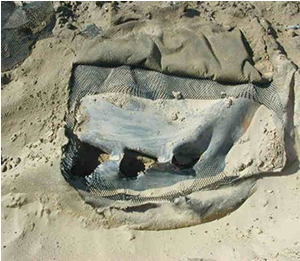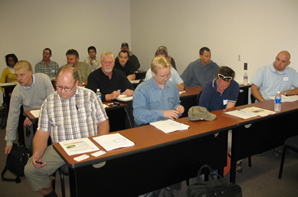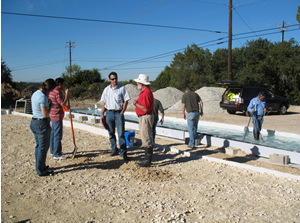 |
The benefits of performing geoelectric leak location or liner integrity surveys (LIS) as the final stage of geomembrane liner construction quality assurance are well established. In fact, the NYS DEC, Division of Solid & Hazardous Materials is proposing regulatory changes to their solid waste management regulations that will apply the practice to the floor secondary (lower) liner of new landfill cells as well as to the primary (upper) liner. Robert Phaneuf of the Division of Solid & Hazardous Materials reports that, based on data obtained from voluntary implementation of LIS on landfill projects where these test methods have been applied as part of the construction quality assurance (CQA) program, a significant reduction in the number of defects has been found when compared to projects that have not had LISs done as part of the CQA program. Phaneuf indicates that the outcome of this is, of course, improved performance of the upper liner system of the double lined landfill with eased start up of these new cells, and significant reductions in leakage flow rates (LFR). The objective of requiring LIS for the lower liner system is to best ensure that all construction related defects in the entire containment system are found and repaired since secondary liner systems will not be easily serviced after operation has begun.
In addition to New York, eight other states require or advise the performance of an LIS as the final stage of landfill liner CQA; Florida, Wisconsin, Minnesota, California, Washington, New Jersey, Texas, and Ohio (discussing).
Developed primarily for landfill liners LIS is now applied routinely to all types of geomembrane containment systems: leachate ponds, waste water treatment plant ponds, anaerobic digesters, farm waste lagoons, potable water reservoirs, fuel oil tank farm secondary containment, canal liners, phosphogypsum stacks, mining solvent extraction settlers/mixers, et al.
 |
The survey technology is very simple. An electric potential is applied across the liner to be surveyed. The potential gradients in the soil or water covering the liner are progressively measured looking for the unique signal that occurs at a penetrating hole (leak). The signal is such that a hole can be located exactly.
Four ASTM standards have been developed by Committee D35 on Geosynthetics to guide proper application of the technology:
- ASTM D6747 is a guide to the method appropriate for a given installation
- D7002 is for surveys on exposed liners using the puddle method. A standard for the water lance technique is well underway
- D7007 is for soil and water-covered liner surveys
- D7240 is for surveys on geomembranes manufactured with a conductive layer on the underside
However, not all lining systems can be surveyed, so designs should be such as to permit an LIS as part of CQA if required. And as-built drawings should be reviewed to determine whether or not a survey on a given lining system can be effective in locating a troublesome leak.
New Opportunities
 |
The need for experienced LIS technicians is growing, with five standards and 9 states supporting the use of surveys. This has created both a need for new practitioners/companies in the field to offer the service, and education to support their successful entrance into the practice.
Until a few years ago surveys were performed only by a few companies that had developed their own equipment and survey procedures. Equipment was not commercially available and there was an aura of high technology associated with its implementation.
In fact, it is far from "rocket science". Correctly interpreting an LIS survey signal takes some practice and coaching, but it can be learned quickly and effectively, as the real science involved is simple electrical theory plus gaining familiarity with the equipment. An LIS requires only four boundary conditions to be satisfied for its successful implementation:
- 1. A conductive medium on top of the geomembrane
- 2. A conductive medium in the holes
- 3. A conductive medium immediately under the geomembrane
- 4. No contact between media above and below the liner other than through the holes being sought
Thus, a single liner with soil on top and over the edges of the liner would not meet Condition 4. A double liner with only a geonet/geotextile composite between primary and secondary geomembranes would not meet Condition 3. Both of these lining systems could not be effectively surveyed without special preparation. Such preparation might require the soil survey to be performed before cover soil is placed at the tops of the side slopes, while backfilling the LDS with water might be required for the double liner.
To encourage the performance of LIS in a proper manner Dr. Ian D. Peggs of I-CORP INTERNATIONAL, Inc., who had been performing surveys internationally since about 1987 (including one with an area of 635,000 m2), and Mr. Sam Allen of TRI/Environmental, an internationally-renowned geosynthetics testing laboratory, informally joined forces to form T-CLIC, the TRI/ I-CORP Liner Integrity Center. T-CLIC’s first task was to develop an educational training program for LIS surveyors and for design engineers and regulators keen to understand the fundamentals, capabilities, and limitations of the technology. The first course was held in April 2004. It is typically held in the spring and fall of each year at the TRI campus in Austin Texas, but has been taken on the road to Albany (NY), Halifax (NS), Edmonton (AB), Houston (TX), and Manila (the Philippines). Class size has varied from 2 to 55.
The instruction component consists of one day in the classroom dealing with the history, patents, theory, boundary conditions, equipment for the different techniques, standards, calibration, field practices, limitations, case histories, and developing technologies. A second day is devoted to hands-on testing in three specially constructed test facilities:
- a water-covered liner,
- a soil-covered liner, and
- an exposed liner with GCL and conductive geotextile substrates, and a conductive geomembrane.
All registrants have an opportunity to try each method. Invariably the soil survey becomes a competition to see whose marker flag is closest to the excavated hole!
The second part of the program is the certification procedure. This is certification to neither a fo
rmal national standard, nor to a GRI/GAI program, but to a standard of practice and understanding of theory established by T-CLIC. For those that have already attended the two-day course and have decided to provide LIS as a CQA service or for their own QC program (e.g. installers), Dr. Peggs attends and audits a production survey to ensure that proper understanding and application of the technology are demonstrated. Major emphasis is placed on the calibration process, the most critical part of a survey. This takes one half to a full day for one or two candidates. Interestingly, there has not been a field audit yet in which a difficulty has not arisen and been surmounted by successful surveyors.
The field audit is immediately followed by a 90 minute closed-book written test of 40 questions. Most are multiple choice questions but with more than one correct answer. Marks are given for each correct answer, and are deducted for each incorrect answer. There are a few sketching and short essay-type questions. Maximum mark is 140, passing mark is 50. No-one has yet exceeded 100 marks. Approximately 60% of candidates pass the test. To date approximately 225 people have taken the two-day course, ~40 have been field audited, and 25 have been certified.
To ensure T-CLIC remains on the right track, an advisory board of industry experts has been appointed to monitor and guide the program. The board includes representatives from the research, owner, engineering, CQA, practitioner, and regulatory sectors.
When significant liner damage, such as that shown below is found, the worth of an LIS is self-evident.
For further course and certification information contact Ian D. Peggs at icorp@geosynthetic.com or Sam Allen at sallen@tri-env.com.
Ian D. Peggs is president of I-CORP INTERNATIONAL, Inc., www.geosynthetic.com











